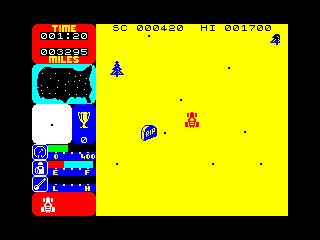Grand Prix Simulator 2 (Codemasters, 1989)
Grand Prix Simulator 2 was released in 1989 with little fanfare and to little notice, I could only find two reviews, Ace giving it 4/5 but SU complaining that the skiddiness of the cornering made it almost unplayable (actually they said it was umplayable, but there you go...) It is as you can see, at heart a Championship Sprint style game, of which the Spectrum had many, including several from the Codies (GPS 1 of course, and before that the BMX series.)
So, why is GPS2 my all-time favourite Spectrum game of all time? Because the skiddiness of the cornering makes it almost unplayable. Almost meaning not quite, and not quite being an invitation to keep improving, slowly, slowly, getting a little further each time until you can finish all 9 courses inside the time limit.
And it gives you split lap times. Somewhere in my dank archives I have graph paper charting my best times for each of the three laps for each course, the best time for each course, and the overall best time to that point. With the laps so short, knocking another tenth off was a real struggle of finding the perfect line through every bend allied to the perfect acceleration (never, never use the brake - if you need to, you've already lost.) As you progress, the courses get trickier, the tracks narrower and the time added for each course vanishingly small. If you don't have at least 34 seconds left at the end of track 1 you won't be seeing track 9 (bad news for me above...) You also take damage every time you hit the scenery or the CPU cars, gradually reducing your top speed and further reducing your qualification chances.
Significantly, though, GPS2 also has the "Meatboy" advantage, because at any time you can press Q then Space and you're instantly back on the start line of track 1, no muss, no fuss. Sounds like a small thing but it really promotes the competitive urge for the perfect start.
Chances are, even if you're a Speccy fan, you've probably never played GPS2, or you've had a quick bash and given it up as umplayable... but each track is short enough to fit a shedload of plays into an hour, by which time you'll learn which 270 degree bends you can take flat out and which you need to take the gas off for, which oil slicks to avoid and which you can compensate for, and the best way to gently block the CPU cars off at the first bend to give yourself a clean run at the track. Now if you'll excuse me, I'm away to set up an Excel spreadsheet and try to get beyond track 5...










































